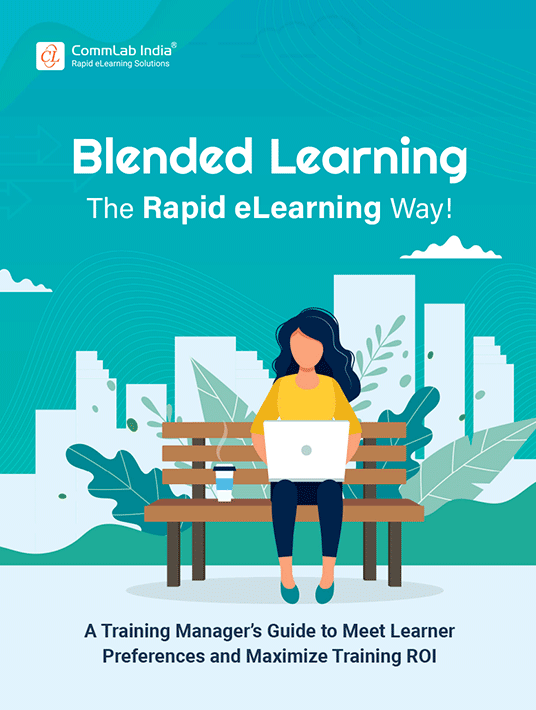Why Blended Learning Strategies Are A Training Manager’s Best Friend
As a training manager, finding the best approach for training learners is your first and foremost priority. Classroom training? eLearning? Microlearning? Virtual instructor-led training (VILT)? There are so many options to choose from. Each training format has something to bring to the table. But don’t we all prefer an à la carte menu over a fixed menu? That’s what blended learning strategies offer – a selection of training formats you can pick and choose from to make your training platter personalized and appealing.

What Is Blended Learning?
Instructor-Led Training + Online Learning (synchronous and asynchronous) + Performance Support
What Do Different Training Formats Bring To The Table?
To understand the benefits of blended learning, it is important to understand why some professionals swear by classroom training while others prefer self-paced training. It is also important to understand the online activities and offline activities for training that can be used in blended learning.
Classroom Training
This training approach has been in practice for ages and remains the most popular method of corporate training. Much of its success stems from ‘the human touch’ i.e., our ability to decipher physical and verbal cues during an interaction – and tailor it accordingly. However, even without social distancing due to the COVID-19 pandemic, classroom training can’t accommodate modern learners’ expectations such as self-paced learning, just-in-time learning, and remote learning. It doesn’t afford the luxury of personalization, individual learning paths, and anonymity.
Virtual Instructor-Led Training (VILT)
VILT in the simplest sense ‘takes the classroom experience to a virtual platform’, where instructors and learners interact without being in the same place, over a virtual conferencing platform.
eLearning
Learning that is electronically mediated is called eLearning. After classroom training, eLearning is the most popular training format used in corporate training. Its self-paced, anytime, anywhere accessibility makes it the most preferred mode of training. It overcomes the barriers of time and space that classroom training can’t overcome and is adaptable to fulfill a myriad of training requirements.
Microlearning
Microlearning is another self-paced training approach that delivers short bites of learning, each focusing on a single learning objective. It is popularly known as ‘bite-sized learning’ because it offers as much information as can be consumed in a short time. Microlearning assets can be standalone or part of a blend. It is also the preferred mode to deliver performance support tools.
Performance Support
Performance support (or job-aids) is all about providing instant solutions to employees in their moments of need. It enables just-in-time learning when learners need instant information for application on the job. Any corporate training program is incomplete without proper performance support.
Benefits Of Blended Learning For Training Managers
Here’s a quick look at the L&D challenges blended learning strategies can help training managers overcome: With blended learning, a major part of your workforce training can be online, reducing the time learners spend in a classroom. Classroom sessions can be limited to creative and collaborative exercises and doubt clarification where the intervention of an instructor is necessary.
VILT allows the benefit of an instructor’s guidance and intervention when it is not possible to gather instructors and learners in the same place. Learners benefit from the flexibility provided by self-paced online training without losing the element of social interaction. In fact, with blended learning, social interactions are not just limited to fellow learners and the instructor but can happen between a much wider group through online forums, communities, and social media. Thanks to rapid eLearning, online training can be rolled out quickly and information can be updated easily (using authoring tools).
Prerequisites To Consider
It’s now time to discuss what you need to implement blended learning for your organizational training. This is very important for training managers – to be fully informed and build a successful business case.
1. Build Awareness In Favor Of Digitization
A major part of corporate training is still done through the classroom because of hesitancy toward digital training. A majority of stakeholders and learners feel wary of technology and its reliability in learning and development. So, building awareness and educating learners and stakeholders about digitization is very important before implementing blended learning.
You can create toolkits and case studies for stakeholders on how online training can benefit the organization in achieving its business goals. There is no shortage of success stories on the topic. You can also educate stakeholders on how different virtual training formats work, what their individual advantages are, and how they can be leveraged together to outdo each other’s disadvantages. To prep leaners, you can launch trailers, create videos, or infographics, and promote the benefits of blended learning through your social media channels. You can use surveys and polls to get responses and feedback from learners about their expectations and doubts.
2. Train The Trainers
Instructors are an important part of classroom training and also for blended learning. For a successful blended approach, you need to have buy-in from instructors too. You can do so by:
- Addressing their concerns about moving training toward a virtual format.
- Involving them while determining what training programs definitely need an instructor’s involvement and what can be done without them.
- Getting them prepped for VILT – on how to use the platform and how to replicate the interactivities of a physical classroom in a virtual one.
- Educating them on new and innovative instruction styles that can be done through virtual classroom platforms like breakout rooms.
3. Ready The Technical Infrastructure
The next step in implementing a blended learning strategy is setting up the infrastructure needed for online training. This means:
- Choosing and setting up a Learning Management System (LMS) as a central hub for all training.
- Assigning a dedicated LMS administrator to monitor all LMS activities.
- Providing learners with necessary devices and a stable Internet connection.
- Choosing an authoring tool for eLearning course development.
- Choosing the platform for VILT, and training learners and trainers on its usage
Creating A Business Case
All the points discussed in this chapter will help you build a successful business case for blended learning to convince your stakeholders. Besides the benefits of blended learning, you can also highlight:
- The cost-benefit ratio of having a blended learning solution rather than a completely virtual or a completely classroom-based approach.
- The opportunity costs saved through online training, without missing out on the human interaction.
- The advantage of using rapid eLearning development for rolling out training programs at the speed of need.
- The economies of scale afforded by eLearning through reusability, standardization, and translations.
- Case studies of different training topics that can be successfully conducted through a blended approach.
Which Industries Can Benefit From Blended Learning?
While blended learning solutions work well across all industries and topics, they are surely a must have to:
- Enliven and keep fresh in learners’ minds dry topics such as compliance training
- Offer a lot of practice opportunities in software training
- Enable continual learning and peer-support for onboarding
- Offer on-demand access and regular interactions with experts for product training
- Provide the human interaction element in soft skills and leadership training
Conclusion: What Is NOT Blended Learning?
Here’s a quick look at what blended learning is not:
- Only classroom training followed by eLearning
- Using technology in the classroom (like using mobiles to take a quiz in the classroom)
- Digital resources uploaded on the LMs for anytime, anywhere access
Blended learning uses online and offline activities to cover different aspects of the same training topic, supplemented by performance support tools.
Download the eBook Blended Learning—The Rapid eLearning Way to get insights on how you can launch a successful rapid blended learning program. Also, join the webinar to learn how to design holistic blended learning solutions for your team.
References:
- Align Your Blended Learning Strategy with Your Business Goals
- Optimizing L&D During COVID-19: A 5-Point Formula for Success
- Become an eLearning Champion
- Unlocking the Potential of Performance Support with Microlearning
- The Need for Rapid eLearning
- Fill your Training Plate from the Online Training Buffet
- 5 Tips to Spice Up New Hire Onboarding Through eLearning









